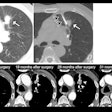The percentage of females and underrepresented minorities in radiology trainee programs has increased in recent years, but only modestly, according to an analysis published May 3 in Current Problems in Diagnostic Radiology.
Female representation among radiology trainees increased at a compound annual growth rate of 1% in diagnostic radiology and 1.12% in interventional radiology between 2016 and 2021. The increases for underrepresented minority representation grew at a 1.12% CAGR for diagnostic radiology in the same period, but it did not grow significantly, according to Sishir Doddi and colleagues from the University of Toledo College of Medicine, NYU Langone Health, and Case Western Reserve University School of Health.
"Our study findings demonstrate modest upward trends in the representation of female and [underrepresented minorities] within radiology trainees from 2016 to 2021," the authors wrote.
Of note, data indicated a "significant evolution" in the percentage of females and underrepresented minorities in interventional radiology (IR) compared with diagnostic radiology, according to the researchers.
In radiology training, numbers of female, African American, and Hispanic trainees have been found to be disproportionally low, even when the diversity of the medical student population is taken into account. For this study, however, researchers counted Hispanic, Black/African American, Native American/Alaska Native, and Native Hawaiin, and the study quantified female and underrepresented minority representation among radiology trainees for diagnostic radiology and radiology subspecialties.
For the years 2016 to 2021, deidentified trainee demographic information for active radiology trainees was queried using the Accreditation Council for Graduate Medical Education (ACGME) and new radiology trainees using the National Resident Matching Program (NRMP)’s Main Residency Match Data and Reports databooks.
Representation for both groups improved over the study period. Furthermore, the integrated interventional radiology training pool "demonstrated a significant evolution."
| Trends in radiology trainees from 2016 to 2021 | ||
|---|---|---|
| Proportion (%) of females | 2016 | 2021 |
| Diagnostic radiology | 26% | 26.7% |
| Interventional radiology | 15.4% | 22% |
| Proportion (%) of underrepresented minorities (URM) | 2016 | 2021 |
| Diagnostic radiology | 6.9% | 11.3% |
| Interventional radiology | 0% | 8.7% |
Also, while the total number of diagnostic radiology trainees decreased from 2016 to 2021 from 4,769 to 4,557, the team recorded an increase in Asian (20% to 26.7%) and Hispanic (3% to 7%) representation from 2016 to 2021. Other groups did not recognize as large a change in the proportion of representation, they said.
"Though active efforts are being made to lower barriers to the pursuit of medical education, a critical aspect of fostering equitable healthcare delivery is ensuring that postgraduate training programs for medical professionals reflect the diversity of the patient population they serve," Doddi and colleagues noted. "Despite encouraging overall trends in representation in undergraduate medical education, the lack of adequate representation of females and [underrepresented minorities] in radiology training programs remains a persistent issue."
The research paper also highlighted that there are persistent barriers to entry into the field. Doddi and colleagues pointed to features of residency programs that rank high with medical students, including their atmosphere, reputation, location, and proximity.
"Many strategies have been implemented over the years to improve recruitment of women and [underrepresented minority] individuals into medicine and individual specialties, including implicit bias training, demographic-specific mentorship programs with individual candidates, and culture-forward initiatives, but strategies may not have done enough to close the gap in women and [underrepresented minority] disparities," the authors noted.
While the study had several limitations, it suggests that residency training programs should continue their efforts to support underrepresented populations.
Read the full article here.




















